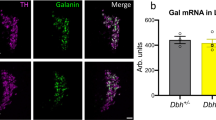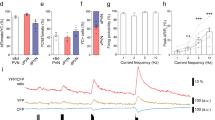Abstract
Stress factors induce neuronal activation in brain areas that are related to anxiety and fear. High doses of caffeine induce neuronal activation with Ca2+ influx followed by expression of the immediate early gene c-fos. In the present study, we investigated c-Fos protein expression in stress-responsive brain areas induced by caffeine, as well as the role of alpha2A receptor in the regulation of neuronal activation. Immunohistochemical analysis showed that an acute effect of caffeine induced c-Fos protein expression in the hippocampus, the bed nucleus of stria terminalis (BNST), the lateral septum, the basolateral and central amygdala, the paraventricular hypothalamic nucleus (PVN), the locus coeruleus, and the lateral parabrachial nucleus (LPBN). However, c-Fos expression was attenuated after repeated treatment of caffeine, spaced 24 h apart, compared to a single acute effect. Alpha2A receptor activation with the agonist guanfacine attenuated the acute effect of caffeine in terms of c-Fos expression in neurons in the CA1–CA3 areas of hippocampus, the locus coeruleus and the LPBN as compared with effect of caffeine alone, whereas the number of c-Fos expressing neurons increased in the lateral septum, the dorsal BNST, the central amygdala, and the PVN, areas that are densely innervated by noradrenergic neurons. Guanfacine alone induced c-Fos protein expression in neurons in the central amygdala, the dorsal BNST, the PVN, the LPBN, and the caudal nucleus of the solitary tract. Guanfacine alone also induced phosphorylation of extracellular signal-regulated kinase 1/2 (ERK1/2) in neurons expressing c-Fos in the dorsal BNST, the central amygdala, and the LPBN. These results suggest that alpha2A receptor activation modulates synaptic transmission in neuronal circuits that are correlated with stress in vivo.









Similar content being viewed by others
Abbreviations
- AR:
-
Adrenergic receptor
- BLA:
-
Basolateral amygdala
- CeA:
-
Central amygdala
- CBP:
-
CREB binding protein
- CREB:
-
Cyclic-AMP response element binding protein
- CREST:
-
Calcium-responsive transactivator
- CRF:
-
Corticotropin-releasing factor
- BNST:
-
Bed nucleus of the stria terminalis
- DG:
-
Dentate gyrus
- ERK1/2:
-
Extracellular signal-regulated kinase 1/2
- LC:
-
Locus coeruleus
- LH:
-
Lateral hypothalamus
- LPBN:
-
Lateral parabrachial nucleus
- NST:
-
Nucleus of the solitary tract
- PVN:
-
Paraventricular hypothalamic nucleus
- PVT:
-
Paraventricular thalamic nucleus
- TH:
-
Tyrosine hydroxylase
References
Aantaa R, Marjamaki A, Scheinin M (1995) Molecular pharmacology of alpha 2-adrenoceptor subtypes. Ann Med 27:439–449
Altman JD, Trendelenburg AU, MacMillan L, Bernstein D, Limbird L, Starke K, Kobilka BK, Hein L (1999) Abnormal regulation of the sympathetic nervous system in alpha2A-adrenergic receptor knockout mice. Mol Pharmacol 56:154–161
Aoki C, Venkatesan C, Go CG, Forman R, Kurose H (1998) Cellular and subcellular sites for noradrenergic action in the monkey dorsolateral prefrontal cortex as revealed by the immunocytochemical localization of noradrenergic receptors and axons. Cereb Cortex 8:269–277
Badowska-Szalewska E, Ludkiewicz B, Domaradzka-Pytel B, Dziewiatkowski J, Spodnik JH, Morys J (2006) The immunoreactivity of c-Fos, NGF and its receptor TrkA after open-field exposure in the central and medial nuclei of the rat amygdala. Folia Morphol (Warsz) 65(2):145–151
Bing GY, Filer D, Miller JC, Stone EA (1991) Noradrenergic activation of immediate early genes in rat cerebral cortex. Brain Res Mol Brain Res 11:43–46
Birnbaum SG, Podell DM, Arnsten AF (2000) Noradrenergic alpha-2 receptor agonists reverse working memory deficits induced by the anxiogenic drug, FG7142. Pharmacol Biochem Behav 67(3):397–403
Buffalari DM, Grace AA (2007) Noradrenergic modulation of basolateral amygdala neuronal activity: opposing influences of alpha-2 and beta receptor activation. J Neurosci 27:12358–12366
Carter AJ (1997) Hippocampal noradrenaline release in awake, freely moving rats is regulated by alpha-2 adrenoceptors but not by adenosine receptors. J Pharmacol Exp Ther 281:648–654
Centini C, Pompeiano O (2007) Sleep research in space: expression of immediate early genes in forebrain structures of rats during the nasa neurolab mission (STS-90). Arch Ital Biol 145:117–150
Cohen BM, Cherkerzian S, Ma J, Ye N, Wager C, Lange N (2003) Cells in midline thalamus, central amygdala, and nucleus accumbens responding specifically to antipsychotic drugs. Psychopharmacology 167:403–410
Crain SM, Shen KF (2008) Low doses of cyclic AMP-phosphodiesterase inhibitors rapidly evoke opioid receptor-mediated thermal hyperalgesia in naïve mice which is converted to prominent analgesia by cotreatment with ultra-low-dose naltrexone. Brain Res 1231:16–24
Davies MF, Tsui J, Flannery JA, Li X, De Lorey TM, Hoffman BB (2004) Activation of alpha2 adrenergic receptors suppresses fear conditioning: expression of c-Fos and phosphorylated CREB in mouse amygdala. Neuropsychopharmacology 29:229–239
Davis AR, Shields AD, Brigman JL, Norcross M, McElligott ZA, Holmes A, Winder DG (2008) Yohimbine impairs extinction of cocaine-conditioned place preference in an alpha2-adrenergic receptor independent process. Learn Mem 15:667–676
Duman R, Newton SS (2007) Regulation of gene transcription in the central nervous system by norepinephrine. In: Ordway G (ed) Brain norepinephrine: neurobiology and therapeutics. Cambridge University Press, Cambridge, pp 95–118
Ebner K, Muigg P, Singewald G, Singewald N (2008) Substance P in stress and anxiety: NK-1 receptor antagonism interacts with key brain areas of the stress circuitry. Ann N Y Acad 1144:61–73
Elizalde N, Carcia-Garcia AL, Totterdell S, Gendive N, Venzala E, Ramirez MJ, Del Rio J, Tordera RM (2010) Sustained stress-induced changes in mice as a model for chronic depression. Psychopharmacology (Berl) 210(3):393–406
Feng H, Xiang H, Mao Y-W, Wang J, Liu J-P, Huang X-Q, Liu Y, Liu S-J, Luo C, Zhang X-J, Liu Y, Li DW-C (2004) Human Bcl-2 activates ERK signaling pathway to regulate activating protein-1, lens epithelium-derived growth factor and downstream genes. Oncogene 23:7310–7321
Forray MI, Gysling K (2004) Role of noradrenergic projections to the bed nucleus of the stria terminalis in the regulation of the hypothalamic-pituitary-adrenal axis. Brain Res Brain Res Rev 47:145–160
Gau D, Lemberger T, von Gall C, Kretz O, Le Minh N, Gass P, Schmid W, Schibler U, Korf HW, Schutz G (2002) Phosphorylation of CREB Ser142 regulates light-induced phase shifts of the circadian clock. Neuron 34:245–253
Gilsbach R, Roeser C, Beetz N, Brede M, Hadamek K, Haubold M, Leemhuis J, Philipp M, Schneider J, Urbanski M, Szabo B, Weinshenker D, Hein L (2009) Genetic dissection of alpha2-adrenoceptor functions in adrenergic versus nonadrenergic cells. Mol Pharmacol 75(5):1160–1170
Girotti M, Pace TW, Gaylord RI, Rubin BA, Herman JP, Spencer RL (2006) Habituation to repeated restraint stress is associated with lack of stress-induced c-fos expression in primary sensory processing areas of the rat brain. Neuroscience 138(4):1067–1081
Hamlin AS, Clemens KJ, Choi EA, McNally GP (2009) Paraventricular thalamus mediates context-induced reinstatement (renewal) of extinguished reward seeking. Eur J Neurosci 29(4):802–812
Hsu DT, Price JL (2009) Paraventricular thalamic nucleus: subcortical connections and innervations by serotonin, orexin, and corticotropin-releasing hormone in macaque monkeys. J Comp Neurol 512(6):825–848
Ma’ayan A, Jenkins SL, Barash A, Iyengar R (2009) Neuro2A differentiation by Galphai/o pathway. Sci Signal 2(54):cm1
Maeda T, Kojima Y, Arai R, Fujimiya M, Kimura H, Kitahama K, Geffard M (1991) Monoaminergic interaction in the central nervous system: a morphological analysis in the locus coeruleus of the rat. Comp Biochem Physiol C 98:193–202
Marrs W, Kuperman J, Avedian T, Roth RH, Jentsch JD (2005) Alpha-2 adrenoceptor activation inhibits phencyclidine-induced deficits of spatial working memory in rats. Neuropsychopharmacology 30:1500–1510
May DE, Kratochvil GJ (2010) Attention-deficit hyperactivity disorder: recent advances in pediatric pharmacotherapy. Drugs 70(1):15–40
Minor BG, Danysz W, Jonsson G, Mohammed AK, Post C, Archer T (1989) Adaptive changes in alpha-2 adrenoceptor mediated responses: analgesia, hypothermia and hypoactivity. Pharmacol Toxicol 65(2):143–151
Monaco L, Sassone-Corsi P (1997) Cross-talk in signal transduction: Ras-dependent induction of cAMP-responsive transcriptional repressor ICER by nerve growth factor. Oncogene 15:2493–2500
Morellini F, Sivukhina E, Stoenica L, Oulianova E, Bukalo O, Jakovcevski I, Dityatev A, Irintchev A, Schachner M (2010) Improved reversal learning and working memory and enhanced reactivity to novelty in mice with enhanced GABAergic innervations in the dentate gyrus. Cereb Cortex 20(11):2712–2727
Nakajima T, Daval JL, Morgan PF, Post RM, Marangos PJ (1989) Adenosinergic modulation of caffeine-induced c-fos mRNA expression in mouse brain. Brain Res 501(2):307–314
Nguyen NK, Keck ME, Hetzenauer A, Thoeringer CK, Wurst W, Deussing JM, Holsboer F, Muller MB, Singewald N (2006) Conditional CRF receptor 1 knockout mice show altered neuronal activation pattern to mild anxiogenic challenge. Psychopharmacology (Berl) 188(3):374–385
Pasumarthi RK, Fadel J (2008) Activation of orexin/hypocretin projections to basal forebrain and paraventricular thalamus by acute nicotine. Brain Res Bull 77(6):367–373
Paxinos G, Franklin K (2001) The mouse brain in stereotaxic coordinates, 2nd edn. Academic Press, San Diego, CA
Perkinton MS, Ip JK, Wood GL, Crossthwaite AJ, Williams RJ (2002) Phosphatidylinositol 3-kinase is a central mediator of NMDA receptor signalling to MAP kinase (Erk1/2), Akt/PKB and CREB in striatal neurones. J Neurochem 80:239–254
Qui A, Ghosh A (2008) A calcium-dependent switch in a CREST-BRG1 complex regulates activity-dependent gene expression. Neuron 60(5):775–787
Sahun I, Gallego X, Gratacos M, Murtra P, Trullas R, Maldonado R, Estivill X, Dierssen M (2007) Differential responses to anxiogenic drugs in a mouse model of panic disorder as revealed by Fos immunocytochemistry in specific areas of the fear circuitry. Amino Acids 33:677–688
Sakai K (1991) Physiological properties and afferent connections of the locus coeruleus and adjacent tegmental neurons involved in the generation of paradoxical sleep in the cat. Prog Brain Res 88:31–45
Savchenko V, Sung U, Blakely RD (2003) Cell surface trafficking of the antidepressant-sensitive norepinephrine transporter revealed with an ectodomain antibody. Mol Cell Neurosci 24:1131–1150
Seale TW, Carney JM, Rennert OM, Flux M, Skolnick P (1987) Coincidence of seizure susceptibility to caffeine and to the benzodiazepine inverse agonist, DMCM, in SWR and CBA inbred mice. Pharmacol Biochem Behav 26(2):381–387
Singewald N, Salchner P, Sharp T (2003) Induction of c-Fos expression in specific areas of the fear circuitry in rat forebrain by anxiogenic drugs. Biol Psychiatry 53:275–283
Starke K, Gothert M, Kilbinger H (1989) Modulation of neurotransmitter release by presynaptic autoreceptors. Physiol Rev 69:864–989
Svenningsson P, Fredholm BB (1997) Caffeine mimics the effect of a dopamine D2/3 receptor agonist on the expression of immediate early genes in globus pallidus. Neuropharmacology 36(9):1309–1317
Szot P, Lester M, Laughlin ML, Palmiter RD, Liles LC, Weinshenker D (2004) The anticonvulsant and proconvulsant effects of alpha2-adrenoreceptor agonists are mediated by distinct populations of alpha2A-adrenoreceptors. Neuroscience 126:795–803
Talarovicova A, Krskova L, Kiss A (2007) Some assessments of the amygdala role in suprahypothalamic neuroendocrine regulation: a minireview. Endocr Regul 41(4):155–162
Tanaka M, Yoshida M, Emoto H, Ishii H (2000) Noradrenaline systems in the hypothalamus, amygdala and locus coeruleus are involved in the provocation of anxiety: basic studies. Eur J Pharmacol 405(1–3):397–406
Trendelenburg AU, Philipp M, Meyer A, Klebroff W, Hein L, Starke K (2003) All three alpha2-adrenoceptor types serve as autoreceptors in postganglionic sympathetic neurons. Naunyn Schmiedebergs Arch Pharmacol 368:504–512
Uusi-Oukari M, Kontturi LS, Coffey ET, Kallinen SA (2010) AMPAR signaling mediating GABA(A)R delta subunit up-regulation in cultured mouse cerebellar granule cells. Neurochem Int 57(2):136–142
Verkhratsky A, Shmigol A (1996) Calcium-induced calcium release in neurons. Cell Calcium 19:1–14
Wang Q, Lu R, Zhao J, Limbird LE (2006) Arrestin serves as a molecular switch, linking endogenous alpha2-adrenergic receptor to SRC-dependent, but not SRC-independent, ERK activation. J Biol Chem 281:25948–25955
Acknowledgments
The authors would like to thank Prof. Clark M. Blatteis for his helpful review of the manuscript and constructive comments. This research supported in part by DC000353 to J.D.B.
Author information
Authors and Affiliations
Corresponding author
Rights and permissions
About this article
Cite this article
Savchenko, V.L., Boughter, J.D. Regulation of Neuronal Activation by Alpha2A Adrenergic Receptor Agonist. Neurotox Res 20, 226–239 (2011). https://doi.org/10.1007/s12640-010-9236-5
Received:
Revised:
Accepted:
Published:
Issue Date:
DOI: https://doi.org/10.1007/s12640-010-9236-5




